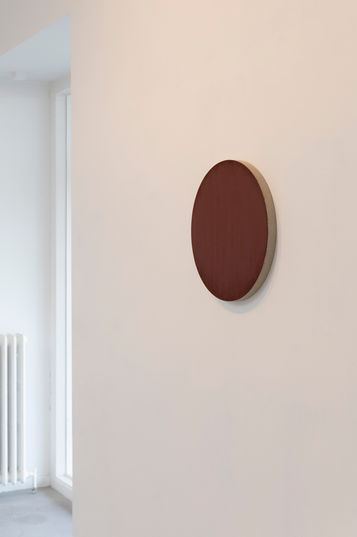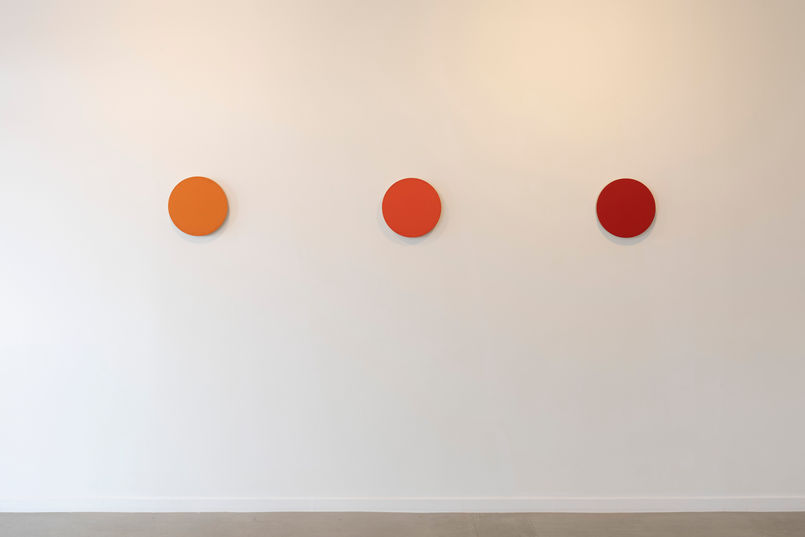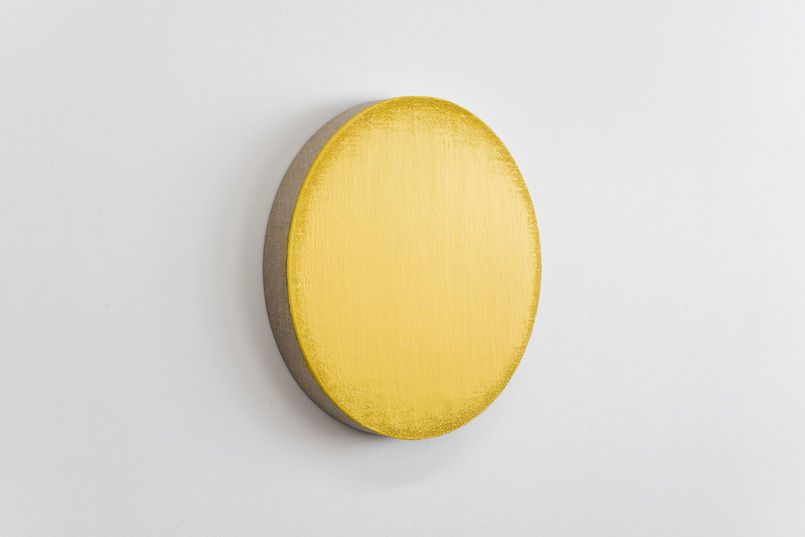
MATTHEW FEYLD
New Paintings
Start exhibition: Sunday 09 April, from 4-8 pm, with a new edition of TROTTOIR
Exhibition > 15 May 2022
Geukens & De Vil, KNOKKE
For more than seven years Matthew Feyld has tenaciously investigated the possibilities of a single motif, the dot. Recently the painter turned within his signature form as a way to push his work forward, first enlarging the dot to become a circle, and now dividing it into a semicircle. To make circle paintings is, in one sense, to explore a common misreading of the dot paintings. This is because the dot, while inherently a circular form, was chosen by Feyld less because it is a type of circle, but more so as a neutral shape to serve as the matrix for his exploration of positive and negative space, presence and absence, and other dualities, with their full range of philosophical, aesthetic, and art historical resonances. The dot in these paintings, which Feyld continues to make as the essential statement of his formal concerns, while initially read by most viewers as a presence—a white dot within a colored ground, is actually the white ground of the painting left unpainted, sitting lower, materially speaking, than the built up painted surface around it. The dot is simply a neutral form through which to direct a larger conversation about dichotomies, like those mentioned, which are a cornerstone of Western culture and thinking, however much they tend to simplify complex situations, as in the case of good/evil, male/female, self/other, etc.
Robert Ryman used white for a similar reason that Feyld turned to the dot, as a neutral vehicle that would allow for other things to become evident. For Ryman this was the interaction of a painting’s different material components with a particular environment. White as a “non-color” and non-referential abstraction via process-based mark-making served as an armature for the viewer to witness, in an elegantly isolated fashion, the play of light and space with painterly components like brushstrokes, different material supports, etc. Then, in 2004, Ryman decided to approach white directly, rather than simply as a tool, consciously making “white paintings” for the first time.
In a sense this is what Feyld did with his circle paintings, developing a tondo format so as to explore the dot motif not as a tool for establishing a certain relationship (both formal and philosophical) within the canvas, but as the primary content and format of the work. In these paintings there is no internal relationship, we must assess them as a totality, a singular shaped surface, comprised, like all of Feyld’s paintings, of meticulously built up layers of different colors. That surface is perceived as unified and definitive, but is informed by all the layers underneath, creating a complex color, not unlike Brice Marden’s monochrome paintings of the 1960s and ’70s. Marden left a margin at the bottom of his layered encaustic surfaces where the accumulated drips reveal both the process and colors involved in the making of the works. Feyld similarly allows the density of the paint along the edges to diffuse somewhat, leaving room for an inquisitive eye to plumb the facture and composition of Feyld’s otherwise uniform surfaces.
Removing the relationship between figure and ground brings up the issue of scale. Within the dot paintings the relationship of the dot, which is centered and whose size is consistent within a small range, with canvases of differing sizes, provides a reliable measure of both size and scale since, as the size of the square canvas changes, so does how the dot relates to the canvas as container, affecting a given work’s sense of scale. However, with the circle paintings the circle becomes a figure, and the wall on which it is hung the ground. Thus the container for the work is the less controllable entity of the wall, and by extension the architecture of the space of display, which dictate our experience of this particular body of Feyld’s work far more than they do his dot paintings. This becomes further complicated by the inclusion of multiple circle paintings alongside one another, as in this exhibition. They begin to relate to one another, as well as to the architecture, creating a play of color and repeated form that is less true of the more self-contained statement of the dot paintings.
Like many familiar geometric shapes a circle produces a gestalt response in the viewer. This in part contributes to these paintings’s sense of material presence, which is underscored by their dense, evidently worked monochromatic paint surfaces. The tondo format also connects the work to painterly traditions extending back at least to the Renaissance. For Feyld to then bisect the circle, as he has done in his newest series, is to shift the focus away from the familiarity of the circular form and move into territory that verges on the expressive. Feyld is now two steps into a self-analysis of his work, and thus the semicircle paintings are as much inflected by his own history as by a larger understanding we may have of the semicircle, which is still familiar, if less so than the full circle. But, where the circle conveys a sense of totality, which is one of the many meanings that are traditionally associated with it, the semicircle implies incompleteness and even fragmentation. Thus, in a way, the semicircle paintings move closer to the dot paintings in their implications because the formal conversation they suggest is once again about the relationship of part to whole.
The absent segment of the semicircle is as much a determining part of our experience of the work as the one that is present. This is especially true when they are, as here, exhibited in series and installed in one of the two orientations the artist has determined for them—with their curve facing up or to the left—and also when displayed near the circle paintings, where what has been “eliminated” is clearly evident. Further anchoring his practice within the terms of a painterly investigation of architectural space via the shaped monochrome canvas, with his latest circle and semicircle paintings, Feyld reveals a direction for his concerns that continues to uncover new room within his by-now established set of conventions involving the circular motif and how it can activate the site of display.
Matthew Feyld, Full Circle
Alex Bacon, London, January 2022

















































